Now you see 'em, now you don't. Watch the Moon occult Neptune and nearby Lambda Aquarii on the same night.
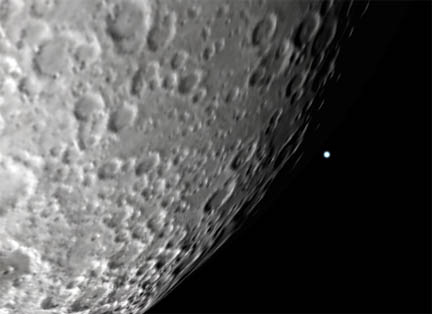
Stellarium
I love magic. It always makes me feel so dumb. That's probably because I'm terrible at figuring out magic tricks. Levitating tables? Death saw? Keep 'em coming! A favorite trick is to make a quarter disappear and then pull it out of someone's ear, a ruse that finds its counterpart in the night sky.
On Friday night–Saturday morning July 22-23, the magician Moon performs a classic magic act when it will make both Neptune and Lambda (λ) Aquarii disappear for about an hour (or less depending on your location) and then return them to view no harm done. Because the Moon will be 88% illuminated at the time, seeing the bright side disappearance will be relatively easy for the star, which shines at magnitude +3.7, but all but impossible for Neptune at +7.8.
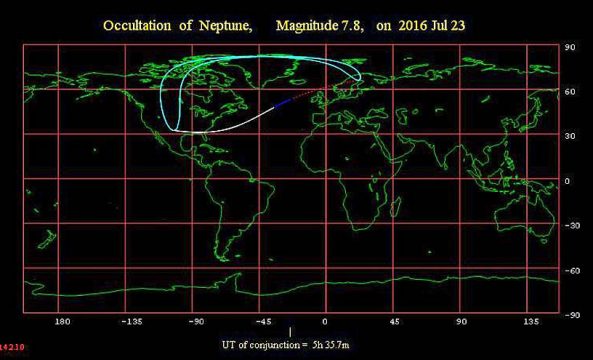
Occult 4.1
Fortunately, both will be visible during their reappearance at the moon's dark limb. A small scope will show the star, but you'll need an 8-inch or larger telescope with clean optics (to minimize scattered light) to nab the planet. Even then it will be a challenge. Both occultations occur within about a half hour of each other with Neptune going first. Interestingly, since both objects are just 30′ apart on that night, the Moon almost glides right between them. But not quite. Because the Moon is near perigee with a diameter of 32′ that evening, it either occults one and narrowly misses the other, or occults both!
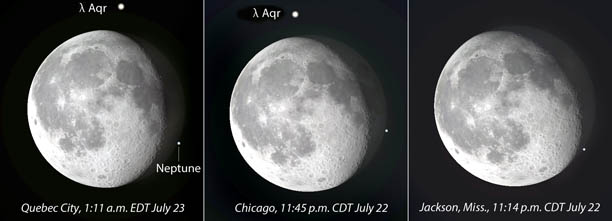
Maps: Bob King; Source: Stellarium
What you'll see depends on your location, which causes the Moon's apparent position to shift this way or that against the more distant background stars, a phenomenon called parallax. Since we're mostly interested in the reappearances of the star and planet, we'll focus on that aspect of the occultation. Neptune returns to view along the Moon's southeastern limb (southwest side in "Earth" directions) around 5:35 UT or 12:35 a.m. EDT July 23rd from many locations across the eastern two-thirds of North America (except Florida).
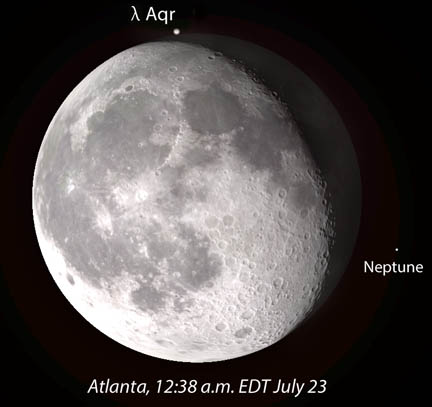
Map: Bob King; Source: Stellarium
Observers on a line from central Texas through central Louisiana and across southern Mississippi, Alabama, and Georgia will witness a grazing occultation, with Neptune scraping along the moon's southern limb.
Not long after the Moon covers Neptune, it will also occult Lambda Aqr for observers in the southern states, Central America, and northern South America. Disappearance will take place around 4:30 UT (11:30 EDT) and reappearance about 5:45 UT (12:45 EDT).
The northern graze line cuts across northern New Mexico and continues through central Oklahoma, Arkansas, Tennessee, and North Carolina. Anywhere north of this line, the Moon misses Lambda, passing just below the star. Skywatchers living south of the Lambda's graze line and north of Neptune's get to see both reappearances!
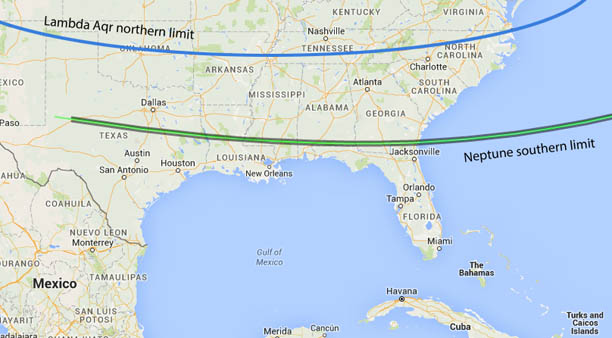
Bottom curve and map: David Dunham, David Herald, Occult software; top curve adapted from the Curt Renz map
What to do if you live in the western U.S. and Canada where the Moon doesn't rise until well after Neptune's reappearance? Use the opportunity to make easy work of finding Neptune. You'll spot it just ½° to ¾° due west of the Moon. For that matter, observers in the far southern U.S., where no occultation will occur, can still use the Moon to find the planet, located a few arcminutes south-southwest of the lunar limb. Neptune displays a pale blue disk through a 4-inch and larger telescopes when viewed at 100x or higher.
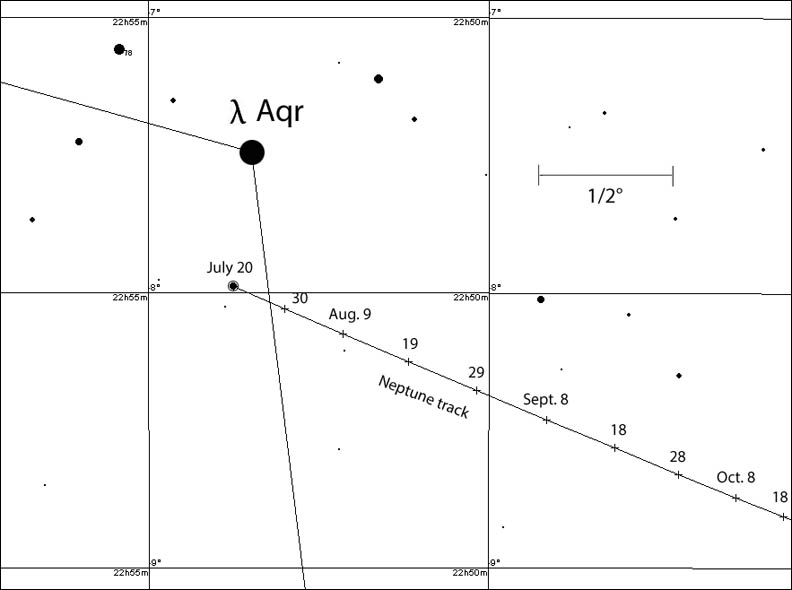
Chris Marriott's SkyMap software
Once the Moon departs the area two nights later, Neptune remains within about ½° of Lambda through month's end, making it an easy catch in telescopes and binoculars any clear night. Center Lambda in your low power telescopic field of view and the pale blue planet will appear a short distance to the SSW. With a 10-inch or larger telescope and magnification of around 200x, try digging out Neptune's brightest moon Triton at magnitude +14. It's not as hard you might think! To help pinpoint its location and confirm your observation check out Sky &Telescope's Triton Tracker. You can also download S&T's Neptune finder chart to track the ice giant into the fall and winter.
Even though the solar system's most remote planet comes to opposition on September 2nd, let yourself get swept up in some Neptunian magic early. The occultation also serves as a preview for a striking dawn conjunction and occultation of Aldebaran by the crescent Moon on July 29th. Clear skies!
 5
5









Comments
John Garlisch
July 22, 2016 at 4:30 pm
I am surprised Dallas is not included in the occultation time predictions, especially since they appear to be in line for both occultation events. Do I need to download and learn Occult 4.1 to do my own prediction or can someone else help me out here? Thanks, and enjoy the magic show!
You must be logged in to post a comment.
Joe Stieber
July 23, 2016 at 3:16 am
Here in southern New Jersey near Philadelphia, I took a look with my 80 mm refractor. The sky was clear, but a little hazy. I could not find Neptune before the occultation started at midnight. I regularly spot Neptune with this scope (and binoculars), but not when the moon is this close, so evidently, the lunar glare washed it out. In contrast, nearby Lambda Aqr was easy to see, and its reddish color was distinctive, but It was not occulted from my location. I finally spotted Neptune at 12:54 am EDT, a few minutes after the predicted end of the occultation (so I did not see it emerge at the dark lunar limb). I suppose the increase in altitude between the start and end of the occultation (from 19 to 27 degrees at my location) made the difference in visibility. Before I packed up for the night, I swung the scope to the east and spotted Uranus, a couple of magnitudes brighter than Neptune, so much easier to see.
You must be logged in to post a comment.
Bob KingPost Author
July 24, 2016 at 7:16 pm
Thank you Joe for sharing your observation of Neptune even if it was a few minutes post-occultation.
You must be logged in to post a comment.
russellbaucum52
July 23, 2016 at 10:32 pm
Due to the hot humid night I choose not to use my telescope ...but instead used my Nikon D-7100 with 1300M/M X 2 on a tripod...the lens is a manual cheapy .....being in the central time zone "Witt,IL." the window was from 11:45 P.M.thru 12:45 A.M. Ended up with forty-something really decent pix of the moon and distinctive moon craters.......but no Neptune nor Lambda Aqr caught hiding beneath the moon!!
You must be logged in to post a comment.
Bob KingPost Author
July 24, 2016 at 7:19 pm
Russell, I think you pushed that camera to the limit, but I suspect the aperture was not enough. Happy to hear about the moon pix 🙂
You must be logged in to post a comment.
You must be logged in to post a comment.